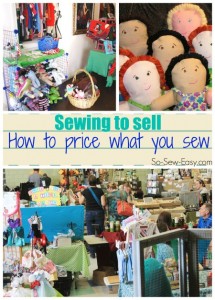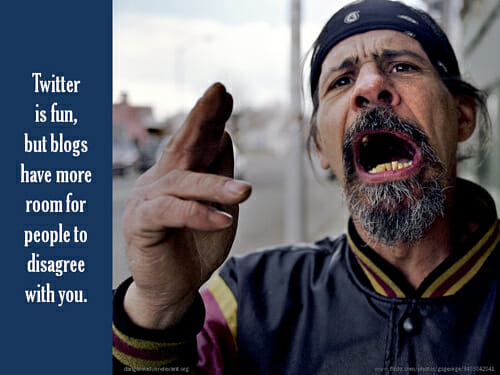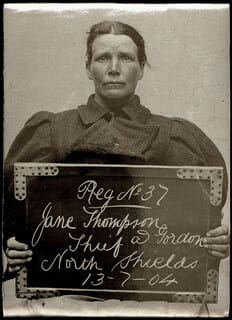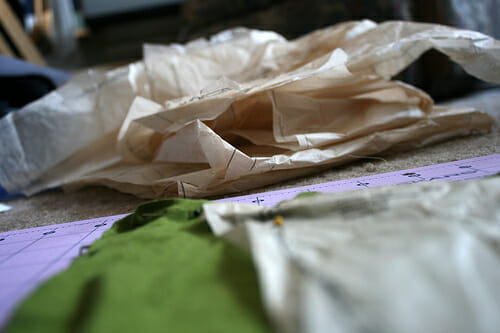
There were a couple of articles in July that had a lot of interest, both about sewing to sell. How to price your work and a round up of projects that are good to sell.




Good to see so many people were interested in this subject, but at the same time I got such a lot of emails telling me that it was illegal to sell things you had made from either someone else's sewing pattern or from licensed fabric. Or that you had to buy a licence from the pattern designer if you wanted to sell an item made from their pattern, known as a cottage licence. Or that if you want to make more than one item (such as 3 matching bridesmaid dresses) that you have to buy a new pattern for each person! Sadly it only proves that there is a lot of misinformation out there that is holding you and your business back!
So I got in touch with a couple of contacts, one of whom is a lawyer, and another who has a lot of personal experience in copyright law, and scoured the internet looking for definitive advice on this subject. There is too much nonsense out there. I had to wade through a lot of people who were apparently stating a fact but in the end were just really passing on hearsay and opinion without any basis in fact at all, and thereby just perpetuating the myth that you cannot sell certain items.
I'm trying to put the record straight here in an easy to understand way, but at the same time it is a VERY complicated area and opinions, even legal opinions, can sometimes vary. Please therefore make your own enquiries with your lawyer if you wish to set up any kind of business and think these sort of restrictions might apply to you and your products. Different laws may also apply to different regions of the world. Check your local laws.
Sewing pattern Copyright law – myths debunked
I'm aware that some of which I state here below may be controversial, and not everyone will either agree with me or like what I say. Of course as usual all comments and feedback are welcome. If you do make a statement of fact that relates to the law regarding sewing patterns and copyright, that contradicts any of these statements below, please provide a source in law where such information can be found and verified. Saying this isn't true because I read it on the internet, only provides even more confusion and passes on inaccurate information which is something we are trying to avoid.


1 – If you make something yourself from a commercially available sewing pattern, it is illegal to sell it because of copyright laws.
Not true. A sewing pattern itself may be subject to copyright law, but that is only the pattern illustrations, diagrams, written instructions and the pattern envelope art (sometimes, again there are limitations). That means that you cannot simply photocopy or scan in the sewing pattern and then sell copies of it. Naturally, I'm sure you wouldn't do that. Although if you look on Etsy there are plenty of seemingly illegal copies of sewing/knitting patterns and even scanned copies of whole books on there. But that's another matter for another day…
You CAN sell things that you make from sewing patterns, with only minor limitations (see later). A pattern is simply that – a template to follow to create a uniform item. You add your own artistic flare to what you create using that template. What you make is your property and is yours to do with as you will.


In legal-ese. Patterns for clothing and other useful items generally are not copyrightable. See Supreme Court – Baker v Selden, 101 U.S. 99, (1878). Even if patterns were copyrightable, the product made from the pattern would not be covered by the copyright. see Baker v Selden, (1878). Copyright owners only have the rights defined under copyright law and cannot make statements that restrict the subsequent use of their product once they have sold it. see Supreme Court – Bobbs-Merrill Co. v. Straus, 210 U.S. 339, (1908)
As you can see, these Supreme Court rulings established certain factors over 100 years ago, and those have not changed since that time.
You might enjoy this interesting TED Talk about copyright in the fashion industry that explains how utilitarian items cannot be subject to copyright.
So if I saw a cat-walk dress I loved, I could create a pattern for how to make a similar item and you could all sew up similar dresses, no problem. That's how the high-street stores are able to create copies of designer clothing.
2 – If you buy an ‘indie' pattern and then find right at the end it says for personal use only, or not for commercial use etc, then you aren't allowed to sell any items you make using that pattern.
Not true. These terms are trying to impose a contract between the pattern seller and the buyer. But for a contract to be legally binding, both parties have to be fully aware of all of the terms of that contract and both expressly agree to them before entering into that contract – at the point of the purchase of the pattern.
In legal-ese. Unless the purchaser agrees to the restriction before the sale. the limitations on the product do not apply. (Bobbs-Merrill Co. v. Straus) The non-commercial limitation is not legally binding upon the purchaser because the manufacturer lacks the legal standing to make such demands.
3 – What about the designers who want to charge you for a ‘licence' to sell what you made from their pattern?
Angel licences, sometimes called cottage licences, are agreements between two parties. If you purchase the pattern without first agreeing to limitations the same applies as in #2. These licences are attempts by designers to get around copyright law. Don't fall for it and pay out money for a licence you don't need and isn't worth anything.
If a pattern designer expresses their wish that you do not sell items created from the pattern, then you may decide to simply use another pattern, there are lots out there. Don't waste your time and money on pattern designers who are overly-restrictive or unco-operative.


4 – You can't sell items made with ‘licensed' fabric, such as Dr Who fabric. That's illegal and the BBC will come after you for making forgeries, illegal copies of their products or going outside of the licence agreement for the fabric.
Not necessarily true. Licensed fabric means the design was licensed by the rights owner to be manufactured. The licence is between those two parties, not between the manufacturer and the fabric buyer. There is no license on the use of the fabric as long as the user insures that when selling the items it is very clear to any potential purchaser that the product is not an officially licensed product but rather made from licensed fabric. We suggest users include a Disclaimer when advertising anything made in this way.
Read more about the use of licensed fabrics here. Are there ‘restrictions' printed in the selvege edge of your fabric? These restrictions aren't legally binding on the fabric purchaser – read more about that here.


5 – What about those designers who insist you ‘credit' them by adding a notice to your sales pages and a tag to the item saying it was made with their pattern?
Depends where you live. American copyright law does not require the original author be given credit as you describe. European copyright law does require attribution but Congress declined to add that to American copyright law. Their demands for credit are not legally enforceable.
6 – You must purchase a pattern for EVERY item you make.
Not true. Patterns are reusable and there is nothing in the law that allows any pattern designer/manufacturer to set such a limit on the number of items that can be produced from the pattern, even if they are items of clothing intended for different people. Imagine if you had two daughters and wanted to make them matching dresses – why would you need to buy two patterns? The same applies even if you are sewing items to sell.
Coming up next
I'll be following up with my opinion in the next article about why I think pattern designers and companies try to put these restrictions on their products. I'll also be happy to tell you more about what is and isn't allowed with So Sew Easy patterns too – basically that's just common sense. You know what's right and wrong!








Great article. I was researching this topic myself recently but as you say most articles on the Internet are opinion or hearsay. I do have a specific question though. I bought remnants at a well known fabric store, one with pictures of storm troopers from Starwars and one with Batman bat logo. Only the Batman fabric had TM printed right on the fabric. If I make articles to sell from these, is there a legal issue? Should it simply be a matter of referencing the item is just made from licensed fabric?
Hi Beverly, thanks for your comment and question. While your question is specific, unfortunately, it may be hard to give a specific answer. Regarding the sale of items made with legally acquired fabric with properly indicated TM protection, I think the law is relatively clear. The court case “Precious Moments, Inc. v La Infantil, Inc, et al.” seemed to uphold the right to produce and sell derivative works from copyrighted fabric as long as it is labeled to indicate the manufacturer and that they have no connection with the holder of the copyright. In terms of the fabric with out the TM printed on it, that raises the question whether it is, in fact, legally produced despite being purchased at a well known fabric store. Suggest you consult with them to determine if the fabric has been manufactured under correct license, in which case you’re probably covered by Precious Moments v Infantil to make derivative works. As always, this is just our opinion and you should probably seek specific legal advice to get an official answer.
According to my copyright attorney, Copyright is enforceable IF it hinders the original artist from selling their product. If you copy something exact and sell it cheaper than the original then you can be sued. Changing a detail on someones original to make it yours does NOT make yours legal. Why do you think there is such a hunt for Knockoffs and when these people are caught are heavily fined? You do not want to be taken to court. To defend yourself against a large Corporation is VERY COSTLY! You do not want to go there for a few measly dollars of profit!! If you suspect or think what you are doing could be wrong then it is….follow your own conscience.
Great article. Pattern and fabric designers are sometimes no different than any other bullies out in the play yard. Amy Butler is a perfect example as seems Lace Faerie’s heirloom designer. They threaten and intimidate to control their product, totally forgetting they are selling an item and once it is paid for it is out of their control. Amy Butler finally had to get rid of her threatening selvedges and web pages. That attitude is a clear way to lose business. Research it out if interested.
While all of this may be true, remember you have to pay to defend yourself if someone sues you. That can be very costly if you are selling fabrics of some of the bigger “protectors” such as Disney or Marvel.
Most of this information is covered by this website for the United States. http://www.tabberone.com/Trademarks/CopyrightLaw/Patterns.shtml
Thanks Judi. That’s a good reference article.
This is the best website I have found relating to copyright laws regarding dress patterns. It sites many court cases by name. It was interesting to learn that the well known patterns makers (McCalls, Simplicity, Vogue, etc) DID NOT copyright their patterns even though it states so on their pattern envelopes. Why? Because they couldn’t. The illustrations (not the printed pattern) and instructions may have copy restrictions one should educate themselves on but the pattern CAN be reproduced legally. I know it’s a sore spot with designers. The manufacturers (like the ones I’ve listed above) are not making anymore money from out-of-print designs so it’s not like anyone is taking away their profits. I suppose it’s a matter of what side of the fence you are on.
I just want to clarify that each country has it’s own copyright legislation – there is no international law.
I’m guessing you are quoting US laws?
I think the people who have commented on this so far are from all over the world. However, there probably is a US bias in the discussion. What’s the view from Denmark and the EU?
In general, what you have stated here is true, but I would suggest adding some clarifying information here since copyright is a little more nuanced when it comes to original works of art. Sometimes, you can run afoul of copyright law in a big way, and that’s when you are making things that are utilitarian but are NOT in the public domain.
There is such a thing as creating a derivative work of something that’s copyrighted, and that is not allowable if the copyright owner has not released those rights.
If I write a pattern for a 4-patch quilt and copyright that, I can maintain my copyright over the written production but not the items made from it. I cannot prevent someone else from making a 4-patch quilt and writing their own pattern, and it’s primarily because the underlying copyright for a 4-patch is unenforceable. (You cannot copyright things in the public domain – shapes, numbers, letters, etc.)
However, if I drew a most fantastic abstract cat, and I copyrighted the cat, and then subsequently wrote a pattern with all the pieces showing you how to make the cat, you couldn’t turn around and make your own pattern from my cat drawing, or take my cat drawing and print up t-shirts with it, or go and make 50 of my cats out of fabric and sell them as appliques, because the underlying copyright is in force. The cat itself is not the utilitarian object, and anything you make from my cat could be considered a derivative work, and would not be allowed unless I give you license to do so.
A company cannot copyright a fork, but if they have a unique enough design or pattern formed into the fork, they could copyright the underlying pattern design, which would prevent someone else from taking that design and making bracelets from it or printing it up on stickers and selling those.
There is a lot of murky case law in this area, but I think what has to be considered is not just whether the pattern is copyrightable, but whether the underlying object the pattern is based on is copyrightable on its own. That’s where you have to be really careful.
It’s why you can’t take a photo that someone else has taken and print it up on mugs. The mug is utilitarian, but the photograph is copyrighted and you do not have permission to make derivative works unless the photographer has released those rights. So yes, “all rights reserved” is still in effect, where it relates to copyright.
So go ahead, make all the dresses and quilts you want, as long as they are considered utilitarian and in the public domain, but when working with something that is based on original artwork, you have to tread more carefully.
http://digitalcommons.law.wne.edu/cgi/viewcontent.cgi?article=1046&context=facschol
http://copyright.gov/circs/circ14.pdf
https://www.legalzoom.com/articles/what-are-derivative-works-under-copyright-law
Also, you wrote a paragraph that talks about copyright statements being unenforceable on the pattern because you can’t enter into a contract unless both parties agree. I think this is true where the copyright statement is on the inside pages and the pattern is sealed in a bag, but if the copyright statement is in plain view (printed on the outside cover, or in the inside cover but not sealed) I think someone could make a case that you knew what you were doing when you bought it. It’s like someone visiting a website and signing up for something, without reading the fine print in the TOS.
I should also state that I’m a pattern designer myself, and I too used to have a convoluted copyright statement on the inside of my patterns, but after reading up on it, I realized that what I was saying was nonsense and offered me no protection. My statement is much simpler now, and just reminds people that they aren’t allowed to copy the physical pattern (other than making a personal use copy if they don’t want to deface the original). Most of the stuff I do is public domain since I use traditional blocks, but if I drew my own artwork, I would definitely want people to understand what they could and could not do with the underlying art.
That’s the way I understand copyright; I’m not a lawyer and don’t profess to be, but I stay away from original artworks because I know there is enough case law to not be 100% sure a judge would rule in my favor. 🙂
Wow. Thanks Ebony. Well, you certainly sound like a lawyer (I don’t mean that as an insult;)) Those are all great comments. I guess it goes to show how truly murky are the rules around copyright that so much can be written without arriving at a clear and simple answer. I’ll let our readers absorb that info and hopefully your comments will spur some more discussion and debate on the topic.
I have a question regarding a crochet pattern. It’s a pattern making dolls of disney princesses. Can they come after you for reselling them?
Hi Torri, there’s a very long and detailed comment just posted on the article that may help answer this question. Please do keep in mind that none of us are lawyers. If you want the 100% definitive answer for your specific circumstance, you should probably get some advice from an intellectual property lawyer. I do think what has been written in the article and subsequent comments can give you some good guidance however. For what it’s worth, my view would be that if the end item is identifiable as a “Disney” princess, you probably don’t want to be replicating and selling it.
Awesome. You create it, then it’s yours to do as you like. Thanks. There is a children’s cartoon that had a show about copying. The creator had an imitator who loved the creators work. The creator became angry and full of hate. In the end the creator learned that it was flattery and not wrong doing. I call this love and creative freedom.
thank you for including citations to the information you provided!
Thank you for such an informative and well laid out article. I always wondered about this because I saw patterns that were exact replicas of more notable pattern makers like Simplicity, McCall, etc. Even some of Vera Bradley’s designs are identical to vintage McCalls (which I just found and purchased from oversees). There is nothing really new under the sun. It’s been done somewhere. Thanks again.
Thanks so much for researching this and sharing your findings. It confirms what I believed to be the truth but …
I did some copyright law research some years back but pertaining to software — also very misunderstood. Anyway, thanks so much. I hope you don’t mind but I made a copy for personal use so that I have a reference if I need it in the future. Also shared a link with a quilting group I follow. I think some of them will be pleased.
🙂
Thank you very much for sharing the article let’s get the word out!
Thank u so much for this information! I’ve got tons of patterns I’ve wanted to make & sell but always been afraid of getting sued for it! I have no problem giving anyone credit for the pattern but I always thought it was the pattern itself that was copyrighted, not the actual item u make from it! So glad u took the time to give us this information!
Wow!
I am impressed by the work that you must have put into this blogpost!
I will definitely recommend it to my fellow seamstresses and quilters since there has been a LOT of fuss around that subject lately, especially since the “Almost Amish” company sued people for selling (or even SEWING!!!) quilts made from the “Light in the Valley” pattern… (not to mention that the particular pattern can be found in Italian embroidery from centuries ago, long before the quilt pattern was created…)
Thank you, thank you, thank you!
Wow, Jane. Glad the company called itself “Almost” Amish, since I understand the Amish don’t believe in suing anyone. How on earth can they sue anyone for sewing a quilt?
The information in this blog is important. I’m grateful because I knew nothing on this subject and am just preparing to make stuffed animals, to sell and to give to children in shelters.
Thank you so much! Very helpful! 🙂
Thank you! This is what I’ve been saying all along. I am a pattern designer too and in my patterns it says “text and images are copyright 2015…” but nothing about what you can sew and sell. Thank you for writing this!
Anita, I’m impressed that you, a pattern designer, wrote such a positive comment. I was in a home-sales business years ago, and we were encouraged to share all secrets with everyone. I like your style.
Thank you. I’ve been telling people this for ages. And they all think they are experts because it says so on the pattern. Thanks for calling BS! And a reminder that “all rights reserved” is obsolete.
Great news – my wife makes items, waistcoats and dresses mainly, and I was wondering where we stood on copyrights… Found this site through “Stitched Up” on Facebook.
excellent.. I have seen SO many items made from licensed material & never wanted to use it to sell.. wonder if the law pertains to Sports ? I know our neighboring state is quite picking about their college football logo..
Hi,
So glad to read a well studied article on copyright!
I do have a question, more about copyright over creations rather than over patterns.
I know a person who (says she) has designed the pattern for a clutch. Someone else, inspired by the beautiful clutch, used the idea (piecing together ribbons- which i believe is not an original idea in itself) to make a clutch! The original maker created a big rukus over it, coming to a point where she actually publicly humiliated the person who had made the clutch for a small craft fair! I found it was really discouraging to the second person, who was a beginner and had said numerous times that she loved the first lady’s clutches and was inspired by them.
Can the lady really copyright the design of her item?
There was this other instance, when a fellow quilter made a quilt which was absolutely breathtaking. But the main element (the jaw dropping element) came from a quilt made by a Japanese quilter. No credit was given. In fact the person claimed the element to be a Japanese fruit, but it was actually a dried flower! The matter here is more of dishonesty, rather than copyright, I know. I believe imitation is the best flattery, but there are people who are fiercely protective of their designs (most of the times they aren’t even original). Can one really protect their designs in the overshared world today?
I loved this answered questions I’ve been pondering for awhile.
Thank you, this is just what I needed to hear! I can now create with impunity! 🙂
Thank you very much for your research and posting this. I have had a pattern I made and copyrighted for a Teddy Bear. I was told by someone that others may copy your pattern if they only change it 10 percent. They can make it. My pattern was not for sale. The Teddy Bears were that I made from my own pattern. The red tape involved was me having to go through a lot of legal processes. I was just not up to it. I did contact this person and told them I had a copyright. To please desist in making it their’s or I would report them. This was so stressful.
However I appreciate your feedback here so much. It totally makes it understandable.
What does the law say about appliqué or embroidery patterns. I bought a whinnie the pooh pattern from etsy and made a t-shirt for a friend. I was immediately told by the girls on an embroidery site I’m on that I can’t sell it but I can give it away. I can’t even recoup my costs.
You can read more about embroidery designs here. It all depends on what terms you accepted when you bought and used the design. http://www.tabberone.com/Trademarks/CopyrightLaw/EmbroideryDesigns.shtml
Well I bought it on etsy and I had the usual script of ‘do not sell the software but you can sell the product’ the question is more about it being a Disney design that I’m guessing won’t be from a licensed company. Also Disney have a clause in all their machines saying that their licensed Disney products are for personal use only and are not to be sold for profits. So if this person from etsy sells me an unlicensed digital file and I turn it into a top could I be liable for a ceased and desist letter from disney
Yes if you have bought an unauthorised product made from a Disney design, then I would suggest not using it on products that you want to sell. Disney really are a special case.
I’d be sorely tempted to say that I sold the t-shirt and threw the embroidery in for free. 🙂
It’s interesting to me that Disney puts itself forward as the purveyors of “Happy-Happy” but, if you step out of line, they are the most vicious gang in the world!
Props for this excellent post. It’s incredibly frustrating to see the myths circulate. I showed up expecting to find yet another list of simply wrong statements, but you’re spot on!
As Karynlee Berstecher noted earlier, what one’s rights are, and what one can do in practice are regrettably different. Websites are under no obligation to respect your rights; many will ban you because it’s easier and safer than dealing with some corporation’s legal threats. The DMCA’s takedown clause means they’re obligated to take your listing down for at least a few weeks, and to not restore it at all unless you formally oppose the takedown. And trademark law is a bit of a mess; there is no amount of care that will make one immune from an abusive company’s legal team. Sure, you might have the right, but the court case is never certain and finding out can easily run $50,000+. 🙁
Regarding 2 – restrictions on use: in the software world, it’s common to print license terms on the box, with a notice saying that, by opening the box, you agree to the terms. Courts have ruled that these “shrink wrap” licenses establish a legitimate contract. I don’t know if this practice has reached the world of clothing patterns.
Does anyone know how this works with digitized embroidery designs? I will say most digitiziers say you can sell items that you stitch out with their designs. They may limit the number of items you can sell with their design. I’m not sure how they would know. There are some that say No, you have to buy a license from them. Their license can be up to $100. Then there are some like Disney that you can buy their designs from Brother’s embroidery site but they can only be used for personal use. There are even Disney designs that are built into Brother Embroidery Machine but again they manual says for private use only. If you go to Etsy, sellers have Disney Designs all the time. It is my understanding that embroidery designs can not be shared and can not be resold. I can understand that but there are so many “rules”, it get confusing.
Digital embroidery designs are software and therefore when you use a software package you usually have to accept some terms and conditions in a click through type of user agreement. It’s different to sewing patterns. So it all depends on what terms you accepted. Disney and Brother do not allow their designs to be sold, and they are for personal use. Terms on other software might vary. You can read more about this here – http://www.tabberone.com/Trademarks/CopyrightLaw/EmbroideryDesigns.shtml
I enjoyed your article.
This poster also helps sum up copyrights.
http://www.dragondreams.ca/CopyrightPoster.jpg
Thank you for this clear presentation.
Wow awesome!!!
This was so helpful and made my life so much easier xoxi
I know Finona. I’m just getting to this article as someone just shared it in a LARGE fb sewing group. Wish I’d known this 5 years ago. Everything they stated that I thought was “illegal” isn’t. 🙂
Very informative. However, what usually gets sellers in trouble is that when they sell their creation, they use the trademarked tags and many online platforms will shut you down if you even receive a cease and desist. I have sen it happen personally. They claim the tag is a trademarked word and illegal. I am wondering if you have some insight on this. And using “(TM name)-inspired” will also get you shut down. Is there a legal leg to stand on here?
It sounds like there isn’t an issue according to your article, but are there any problems with buying commercial clothing and remaking or altering them and then selling the product?
This isn’t something I have investigated, but I would suggest that if it is no longer the original item as bought from the store, you would need to remove the store/brand label when you resell it, to make sure you aren’t misleading anyone about who created the new garment.
A part of my business is this, I buy organic shirts and then screen print my designs on them. I spoke with the Canadian Compliant Bureau and they stated to me that the original tags must remain but I can add on my own (can’t cover up the original though because consumers with questions about the actual fabric need to contact the manufacturer which would not be you, it would be the company you purchased the clothes from) My worry was people will see my shirts and associate it with the store I buy my shirts from but adding my own tag and all my information will clear things up and in Canada that is all that is required. Saves me from having to send in my shirts from re-testing and paying to have that done (which can cost thousands) but that’s only in Canada, not sure how it works elsewhere. Oh and it is fine to do as long as you make it clear that you have altered the original product but still have to mention where it is from in case they have issues.
That’s really useful information, thank you Jessica.
What an informative article! I’ve only heard the negatives on this and believed them. Hearing this from you, a trusted blogger, I am going to share this information to my sewing guild. I loved the Ted talk and thank you for including a link to that as well. I’ve been considering entering the garment/craft selling market and was concerned about copyrights so this came at a good time.
Thank you so much for the info.
Thank you very much for this post. It agrees with everything I have found when I researched the subject. Hopefully enough people become aware of this so crafters are not called out or bullied because they are selling something made from a pattern they purchased or found in a tutorial. If someone does not want you to sell something from a tutorial than they should not post the tutorial.
I agree!
I came upon your site on pinterest. The information in your blog is priceless. Thank you so very much.
Mad Margaret
THANK YOU SO MUCH FOR THE LINK IT WAS VERY INFORMATIVE & WORTH THE READ
When selling an item crafted from licensed material, auction titles are important. For example, lets say you are selling a baby bib made from licensed Disney fabric. Your action title should read something like this:
Baby Bib Made From Winnie The Pooh Fabric
Not something like this:
Winnie The Pooh Baby Bib
And not something like this:
Winnie The Pooh Baby Bib Home Made
The first auction title is more precise and cannot be considered deceiving.
Disclaimer Do’s and Do Not’s
Do put a disclaimer close to the top of the listing before the picture.
Do Not put the disclaimer only at the bottom of the listing unless it is there a for second time.
Do Not put your disclaimer in smaller font or cutsie font. It must be in font as large as your listing.
Do Not get overly wordy and long-winded in your disclaimer. Just the facts.
Do Not make your disclaimer hard to read with fancy colors and backgrounds.
A disclaimer only at the bottom of the listing could be ignored and then it would be ineffective. Effective disclaimers at the top and the bottom of a listing are almost impossible to ignore. Effective disclaimers are your friend. Use them. You want the wording of the disclaimer in the same size font as the description. We recommend something like what we call the Tabberone Disclaimer. It is large enough to be seen easily and colorful enough to attract attention but it does not detract from your message which is that product which you are trying to sell:
This is not a licensed Disney product.
It is however, hand-crafted from licensed Disney fabric.
I am not affiliated with or sponsored by Disney Enterprises.
I am still awaiting any replies to this question? It must be a hard one to answer but if I buy for my Brother machine can I then sell an item that is made from Disney Fabric & has a Disney design on it? I have paid for both & they are not cheap so can
I then turn around & sell a baby blanket that I have made using both?
These designs are very specific to the Brother machines and are exclusive to them. Because it is Disney who are very aggressive in protecting their trademarks, I suggest you contact Brother for a definitive answer to this about what the licence allows. It may also be covered in the original manual that came with your machine.
Thank you for posting this. I’ve been explaining this one to people for years, but they still continue to fall for the myths.
Thank you for the great article! There is so much misinformation out there, fear mongering, too.
There is a designer of old fashion baby clothes and gorgeous hand embroidery and I would love to buy her patterns but she so adamant about not using her purchased designs on items to sell, that I won’t buy them. I’d hate to be accused of copyright infringement if I accidentally reproduced a simular item after seeing hers. The strength of her disclaimers comes off as snotty and hauty. Too bad,too, ’cause on her blog she seems very nice. She’s lost out on sales to me.